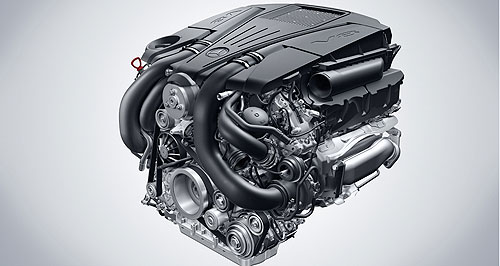Future models - Mercedes-Benz - CL-classLess is more for new Benz enginesBlown it: Mercedes-Benz has opted for dual turbos for its new 4.7-litre V8 - one of two new engines announced by Benz. Mercedes pumps up V8 performance and economy with smaller, hi-tech turbo engine10 May 2010 MERCEDES-BENZ has turned to turbocharging, state-of-the-art fuel injection systems and low-friction design for a new, downsized 4.7-litre V8 engine that cuts fuel consumption by 22 per cent and yet increases power by 12 per cent over the 5.5-litre engine it is set to replace. The Stuttgart car-maker has also announced a new narrow-angle 3.5-litre V6 petrol engine that will make significantly more power and torque while delivering a 24 per cent fuel economy improvement over the existing unit. Both engines will debut in the Mercedes range later this year, with the V8 set to appear in the new CL500 due in the third quarter. The move to a smaller V8 at Mercedes comes just a month after its performance arm, AMG, announced that it, too, was downsizing its big-bore bent eight from 6.2 to 5.5 litres. That twin-turbo engine, packing 400kW, will also debut in the AMG’s hot-shoe CL-class variant in the fourth quarter. The mainstream 4.7-litre V8 – actually 4663cc – is 15 per cent smaller than the current V8 used in a swag of Mercedes models, including the E-class, S-class, CLS and ML and GL SUVs. Power is up from 285kW from the 5.5-litre unit to 320kW in the new engine, and yet fuel consumption is down from 12.3 litres per 100km to an impressive 9.5L/100km in the forthcoming CL. By comparison, BMW’s 4.8-litre V8 develops 270kW and drinks between 10.3L/100km and 12.9L/100km, depending on the application, while Audi’s 4.2-litre V8 makes 302kW and returns between 11.9 and 14.6L/100km.  Left: Mercedes-Benz 4.7-litre twin-turbo V8 engine. Below: Mercedes-Benz 3.5-litre V6. Left: Mercedes-Benz 4.7-litre twin-turbo V8 engine. Below: Mercedes-Benz 3.5-litre V6.Low pressure, 0.9-bar turbochargers – one on each bank of cylinders in the alloy block engine – are among the keys to the Mercedes V8’s impressive figures. Mercedes says the blowers have been configured for high torque at low engine speeds, with maximum torque of 700Nm kicking in from just 1800rpm to 3500rpm. Tellingly, 600Nm of torque is available all the way from 1600 to 4750rpm. Mercedes claims no perceptible turbo delay and the driving feel of a naturally aspirated 7.0-litre engine. Fuel savings are aided by third-generation direct injection using piezo injectors with spray-guided combustion. Idle-stop saves more fuel by cutting the engine at the traffic lights, while the load from ancillary equipment on the engine has been cut with adoption of the latest pump technologies for water, oil and fuel, plus an “intelligent” generator. The new V6 has a cylinder block V angle of 60 degrees, compared with the current unit’s 90 degrees. Mercedes says this allowed it to dispense with the counter-rotating balance shaft without loss of refinement. Unlike the V8, the new V6 is normally aspirated and retains the same 3.5-litre displacement as the current powerplant, but still manages 25kW more power, to 225kW at 6500rpm, 20Nm more torque, to 370Nm from 3500 to 5250rpm, while slicing fuel consumption to 7.6L/100km in the S-class – a saving of 24 per cent. The V6 – which Mercedes says can be turbocharged – features similar advances in injection technology to the V8, along with a variable-resonance induction system and revised exhaust. Both engines also use multi-spark ignition, allowing up to four sparks in a millisecond for improved combustion. Hand in hand with improved fuel consumption, both engines emit less carbon dioxide. In the case of the V8, CO2 is down 22 per cent, from 288g/km to 224g/km in the CL500, while the V6 notches up a 24 per cent improvement, to 177g/km. Mercedes says its V engines have been subjected to 52,000 hours of test-bench trials and seven million kilometres of on-road testing.  Read moreAll future models Alfa Romeo Alfa Romeo Abarth Abarth Audi Audi Aston Martin Aston Martin BMW BMW Bentley Bentley Chrysler Chrysler Chevrolet Chevrolet Dodge Dodge Citroen Citroen Ferrari Ferrari DS DS Ford Ford Fiat Fiat FPV FPV Foton Foton Haval Haval Great Wall Great Wall Honda Honda Holden Holden Hyundai Hyundai HSV HSV Isuzu Isuzu Infiniti Infiniti Jeep Jeep Jaguar Jaguar Lamborghini Lamborghini Kia Kia Lexus Lexus Land Rover Land Rover Mazda Mazda Maserati Maserati Mercedes-Benz Mercedes-Benz McLaren McLaren Mini Mini Nissan Nissan Mitsubishi Mitsubishi Peugeot Peugeot Opel Opel Proton Proton Porsche Porsche Renault Renault Ram Ram Saab Saab Rolls-Royce Rolls-Royce Smart Smart Skoda Skoda Subaru Subaru SsangYong SsangYong Tesla Tesla Suzuki Suzuki Toyota Toyota Volvo VolvoMotor industry news |
Click to shareMercedes-Benz modelsResearch Mercedes-Benz All future models Alfa Romeo Alfa Romeo Abarth Abarth Audi Audi Aston Martin Aston Martin BMW BMW Bentley Bentley Chrysler Chrysler Chevrolet Chevrolet Dodge Dodge Citroen Citroen Ferrari Ferrari DS DS Ford Ford Fiat Fiat FPV FPV Foton Foton Haval Haval Great Wall Great Wall Honda Honda Holden Holden Hyundai Hyundai HSV HSV Isuzu Isuzu Infiniti Infiniti Jeep Jeep Jaguar Jaguar Lamborghini Lamborghini Kia Kia Lexus Lexus Land Rover Land Rover Mazda Mazda Maserati Maserati Mercedes-Benz Mercedes-Benz McLaren McLaren Mini Mini Nissan Nissan Mitsubishi Mitsubishi Peugeot Peugeot Opel Opel Proton Proton Porsche Porsche Renault Renault Ram Ram Saab Saab Rolls-Royce Rolls-Royce Smart Smart Skoda Skoda Subaru Subaru SsangYong SsangYong Tesla Tesla Suzuki Suzuki Toyota Toyota Volvo VolvoMotor industry news |















Facebook Twitter Instagram